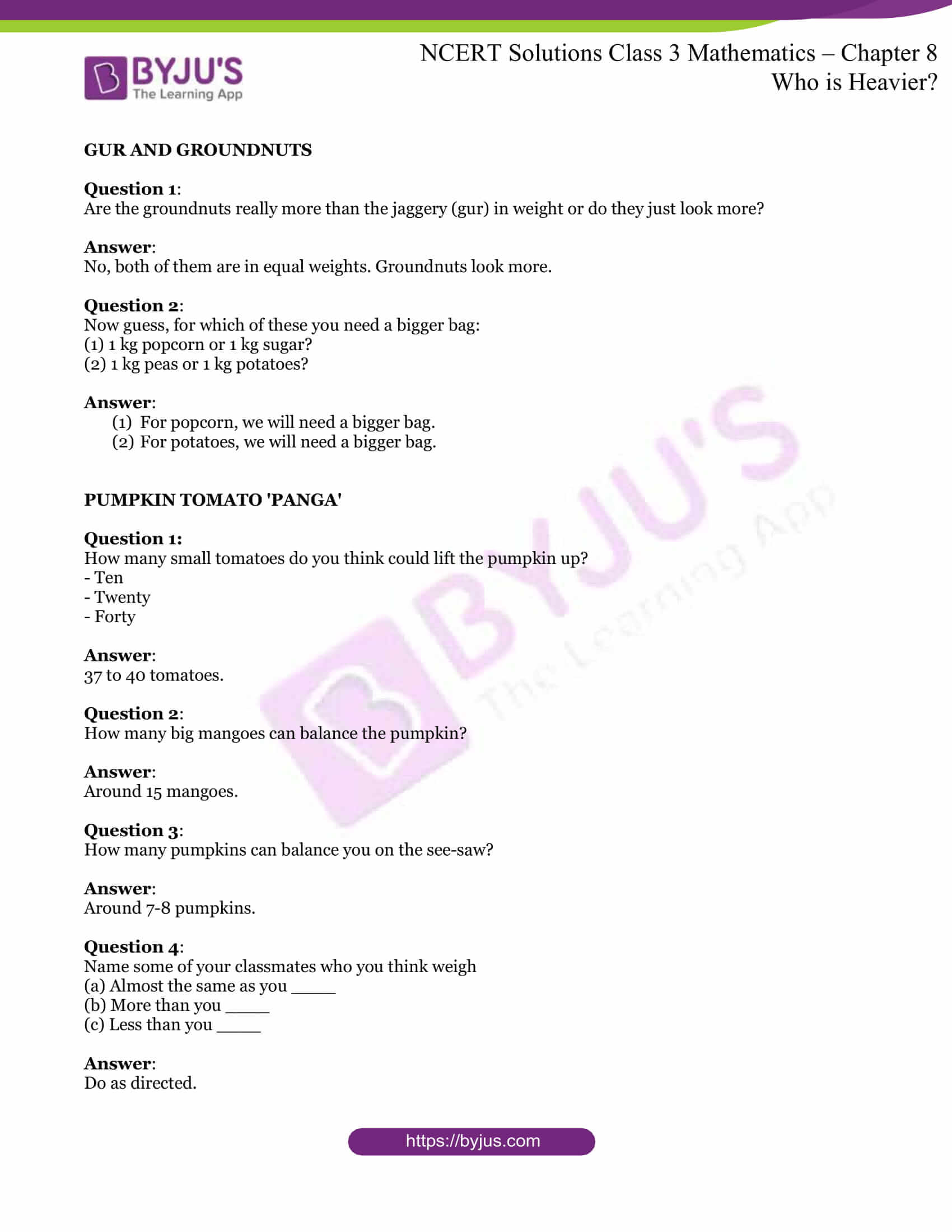To teach kids the concept of weight, the chapter Who is Heavier uses lots of stories and puzzles. It also introduces kids to balances. Here, we are offering you NCERT Solutions For Class 3 Maths Chapter 8 Who is Heavier. We have solutions for all the questions in the textbook including practice time questions and puzzles.
The solutions have been designed as per the standards set by CBSE. These solutions have been written in an easy-to-understand language. NCERT Solutions for Class 3 Maths will help students get a clear idea of how they need to answer the questions of the textbook. You can download these solutions in PDF format for free.
Download the PDF of NCERT Solutions For Class 3 Maths Chapter 8 Who is Heavier?





Access Answers to NCERT Class 3 Maths Chapter 8 Who is Heavier?
GUR AND GROUNDNUTS
Question 1:
Are the groundnuts really more than the jaggery (gur) in weight or do they just look more?
Answer:
No, both of them are in equal weights. Groundnuts look more.
Question 2:
Now guess, for which of these you need a bigger bag:
(1) 1 kg popcorn or 1 kg sugar?
(2) 1 kg peas or 1 kg potatoes?
Answer:
- For popcorn, we will need a bigger bag.
- For potatoes, we will need a bigger bag.
PUMPKIN TOMATO ‘PANGA’
Question 1:
How many small tomatoes do you think could lift the pumpkin up?
– Ten
– Twenty
– Forty
Answer:
37 to 40 tomatoes.
Question 2:
How many big mangoes can balance the pumpkin?
Answer:
Around 15 mangoes.
Question 3:
How many pumpkins can balance you on the see-saw?
Answer:
Around 7-8 pumpkins.
Question 4:
Name some of your classmates who you think weigh
(a) Almost the same as you ____
(b) More than you ____
(c) Less than you ____
Answer:
Do as directed.
Question 5:
How many books can you lift on one hand keeping your arm straight?
Answer:
4 books.
DOUBLE HER WEIGHT
Question 1:
When Kunjamma was born, she was 3 kg. Today is Independence Day and Kunjamma is 5 years old. She is 28 kg now.
Now guess her weight and the amount of sweets her parents distribute every Independence Day.
Answer:

YUM YUM RICE
Question 1:
Fill in the blanks-
_____ peas
_____ water
_____ onions
_____ salt
_____ mustard seeds
_____ red chilli powder
Answer:
1 bowl peas
8 glasses water
2 onions
1 pinch salt
2 spoons mustard seeds
1 spoon red chilli powder
ACTIVITY TIME
Question A:
Make a list of things bought at your home. Find out how much of each thing is bought at one time. These things can be rice, oil, chilli powder, sugar, milk, onions, ginger, etc.
Answer:
| Things | Amount | Things | Amount |
| Rice | 5 kg | Groundnut | 2 kg |
| Wheat | 5 kg | Chilli Powder | 250 gm |
| Dal | 5 kg | Milk | 1 litre |
| Sugar | 2 kg | Onions | 2 kg |
| Salt | 2 kg | Ginger | 250 gm |
| Turmeric Powder | 250 g | Tea | 500 gm |
| Coriander Powder | 250 g | Oil | 1 litre |
Question B:
Guess their weights and match.
Answer:

Question C:
Guess which of the following things weigh more than 1 kilogram? Which ones will weigh less than 1 kilogram (kg)?
Answer:
i) Your school bag – more than 1 kg
ii) Geometry box – less than 1 kg
iii) A brick – more than 1 kg
iv) A big pumpkin – more than 1 kg
v) Your pair of slippers/shoes – less than 1 kg
Question D:
Use your balance to find which of the following is heavier —
i) A water bottle or a cricket ball
ii) Your shoe or your pencil box
iii) Your Maths book or Hindi book
iv) Your bag or your friend’s bag
Answer:
i) Water bottle is heavier
ii) Shoe is heavier
iii) Maths book is heavier
iv) My bag is heavier
Question E:
Weigh 1 kg of mud or sand. Divide it equally into 2 bags. Use the balance to check if both the bags have equal weight. Weigh 1 kg of mud or sand. Divide it equally into 2 bags. Use
the balance to check if both the bags have equal weight.
Answer:
Do as directed.
Question:
Make a list of
i) Things weighing less than half kg.
ii) Things weighing more than half kg.
Answer:
i) Things weighing less than half kg: cup, glass, empty water bottle, bulb, etc.
ii) Things weighing more than half kg: chair, fan, pumpkin, table, television, etc.
LOOK FOR WEIGHTS AND BALANCES
Question 1:
Make a trip to your nearest junk dealer, vegetable shop and grocery shop. Have a look at the weights they use. Find out:
i) Who uses the biggest weight?
ii) Who uses the smallest weight?
Have you seen any of these balances?
Answer:
i) The junk dealer uses the biggest weight.
ii) The grocer uses the smallest weight.
Question 2:
Have you seen any of these balances?
Answer:
Yes, I have seen all these types of balances.
Question 3:
In which shop would you find the following types of weights?
Answer:
The shops which sell grains and gems, use such types of weights.
